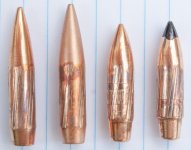I have a partial box of Remington Match ammo that is from the 1950's. One day I took it along with boxes of the supermatch Federal ammo made for the (92?) Olympics, and Eley 10X and several other boxes of match ammo I had to see what my old Winchester model 57 sporter would shoot best. They were all about the same except the ancient Remington Match, which shot groups half the size of any of the others.
Regarding bullet tilt, some more careful explanation for how it affects good, symmetrical bullets is in order. In the simplified and exaggerated drawing below, you can how tilt moves the center of gravity (aka, the center of mass) off the boreline. In that position, you can see the CG orbits the boreline as the bullet spins. This is like spinning a weight in a circle on the end of a very short string. When you let go of the string, the weight takes off sideways at a tangent to the circle of spin. In the rifle, the "string" is released when the bullet clears the muzzle. The bullet is also going forward very fast at the time, but that tangent motion has momentum that is independent of the forward momentum and it drifts the bullet off the center of the group being printed on paper.
Two important things that affect the result:
- The further forward the CG is from the center of tilt and the more degrees of tilt, the bigger the radius of the CG orbit around the boreline, so the faster the orbit is and the more drift it introduces.
- The faster the rate of spin, the faster the orbit and the resulting drift it introduces.
From the above, a couple of things will be apparent:
Since tilting the bullet in the bore squeezes one front edge and its opposite rear edge of the bearing surface against the bore, there is a limit to how far you can tilt the bullet before the force against those opposite edges is great enough to straighten out any further tilt. Bullet tip tipping on the order of four or five-thousandths off-axis (0.008"-0.010" TIR) is a typical limit. Longer bearing surfaces will allow less tilt.
The amount by which CG's are offset by tilt is typically under half a thousandth of an inch, so it takes some fast spin to develop the centrifugal effect that lets the bullet take off sideways.
If there is no distance between the CG and the center of tilt of the bearing surface, as is the case with a double-ended wadcutter, for example, then tilting the bullet will not move the CG away from the bore line and no drift effect will be introduced at any rate of spin.
In the case of the 22 Long Rifle, several things suggest bullet tilt should have little effect on it. The blunt shape will not put the CG very far from the center of tilt. It's not a wadcutter, but most modern high power rifle designs depend on a long Spitzer nose to pull the CG forward of the center of tilt at the bearing surface center and this causes the lateral drift effect to be a significant issue when concentricity is poor.
Second, the 22 LR spin rate is low, with a 16-inch rifling pitch and velocities in the vicinity of Mach 1. Where a 40-grain bullet from a 223 Rem barrel with 9" twist at 3200 fps will be spinning at 256,000 r.p.m., a 1200 fps 22 LR from a 16" twist barrel will be spinning 54,000 rpm. So, even if the 22 LR bullet had a long, pointy nose to pull the CG forward, it would only cause that CG to orbit the bore centerline at about a fifth the speed the 223 example does, and that would cut the drift velocity to about a fifth of what the 223 sees.
On the other hand, the 22 LR TOF is longer, but not five times longer. So the effect will be there, but overall probably only on the order of a tenth of what you would see with the 223.


